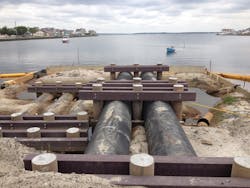About the author: Steve London is president of Steven London Associates. London can be reached at [email protected] or 813.645.0209.
Water is discharged into Barnegat Bay.
Running along the Barnegat Peninsula—a thin sliver of land located between the Atlantic Ocean and Barnegat Bay in Ocean County, N.J.— Route 35 is not just any road, it is the main road. When Hurricane Sandy struck New Jersey Oct. 29, 2012, it left unparalleled devastation in its path, and the segment of Route 35 between Bay Head and Seaside Park was no exception.
The Barnegat Peninsula sits just a few feet above sea level. Flooding always accompanies typical summer storms, but Sandy redefined storm damage, breaching Route 35 in three places, cutting channels that connected the Atlantic Ocean with Barnegat Bay, and making the peninsula inaccessible for weeks.
With this critical coastal evacuation route severely compromised, the New Jersey Department of Transportation, led by Project Manager Ahmad Qureshi, took immediate steps to restore safe travel: A complete reconstruction of a 12.5-mile section of Route 35 would be required. An investment of this scale demanded a solution for the routine flooding problems faced by the area.
Nabil Hourani, P.E., associate and project manager for McCormick Taylor, was tasked with the drainage and storm water management redesign. He concluded that the only way to provide real relief from flooding in this highly developed, low-lying area would be to incorporate storm water pump stations into the design. The Federal Highway Administration concurred and funded the project through its Emergency Relief Program, including a new drainage system with nine pumping stations as part of a stronger, more resilient roadway.
Nine underground pumping stations were installed.
Propelling Construction
With accelerated design and construction schedules, substantial completion of the Route 35 reconstruction was planned by the summer of 2015. A compact footprint was critical to expedite this project by keeping the pump stations within available rights-of-way. Dave Applegate, associate principal for PS&S, and his team designed the mechanical and electrical systems and provided architectural design coordination for the storm water pump stations, with 15 days to prepare the public bid documents, a process that normally would take months. Ana van den Hende of Pumping Services Inc., the local Flygt representative, provided immediate technical assistance and guidance for pump selection and station optimization.
Slimline propeller pumps were selected for all nine underground storm water pumping stations; the small profile of the propeller pumps reduced the required pump station footprint with smaller column pipe diameters and pump bay widths.
Slimline propeller pumps also utilize Formed Suction Intake (FSI) devices. The FSI inlet device provides optimal inflow to the propeller pump by gradually accelerating and redirecting the flow toward the pump inlet; its primary function is to condition the incoming flow into a uniform profile and redirect the flow. The device is ideal for use when space is limited; by providing a reliable pump intake in limited space, the FSI is able to achieve better hydraulic conditions within a smaller footprint than with standard inlet devices.
The largest pump stations are able to convey 36,000 gal per minute (gpm) with a five-pump arrangement (each pump capable of 9,000 gpm, with one pump as a spare). Xylem’s MultiTrode MultiSmart pre-programmed controllers were used for their ability to run multiple pumps without complications.
Pumps With a View
Among the challenges was minimization of the visual impact of the pump stations in scenic waterfront locations. Electrical components were positioned 12 ft above the Advisory Base Flood Elevation within gazebos, which visually conceal technical components and protect control systems from high water levels. Water quality treatment facilities were incorporated upstream of each pump station including an oil-water separator with bar screen and a manufactured treatment device to remove suspended solids from storm water prior to discharge into Barnegat Bay.
Route 35 was reconstructed as a roadway able to withstand the most intense future storms. The pump stations and drainage system improvements will prevent flooding for the 25-year storm, enabling safe evacuation of the community, while relieving flooding from many local roads that formerly flooded on a frequent basis. Flygt applications engineering was able to assist with a challenging coastal storm water design.
A segment of Route 35 in Ocean County, N.J., was flooded during Hurricane Sandy, prompting construction of flood control measures.


